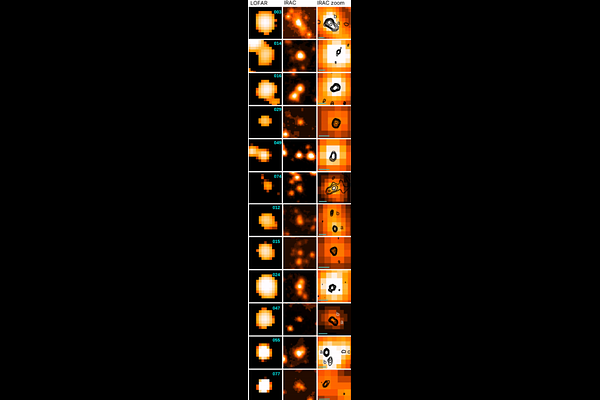Sub-arcsecond-resolution LOFAR observations of bright sub-millimetre galaxies in the North Ecliptic Pole field

Sub-arcsecond-resolution LOFAR observations of bright sub-millimetre galaxies in the North Ecliptic Pole field
M. Bondi, I. Prandoni, M. Magliocchetti, L. Bisigello, M. Bonato, M. Giulietti, R. Scaramella, G. Brunetti, F. Vitello
AbstractBright SMGs contribute significantly to the star formation rate (SFR) density (20-50\%) and stellar mass density ($\sim$ 30-50\%) at $z=$ 2-4 with SFRs$\ge 1000$ M$_\odot$,yr$^{-1}$ and stellar masses of $\sim 10^{11}$-$10^{12}$ M$_\odot$. The number of bright SMGs with such high SFRs is hard to reconcile with the standard models of galaxy formation and evolution. In this paper we provide evidence that, in a small sample of 12 bright SMGs, the SFRs derived from spectral energy distribution (SED) fitting are significantly higher than those obtained using low-frequency radio emission as a proxy for star formation. Using the International LOFAR Telescope (ILT), which allows imaging at 144 MHz with sub-arcsecond angular resolution, we have produced deep images of a small sample of bright SMGs in the North Ecliptic Pole (NEP) field extracted from the NEPSC2 survey. For all 12 SMGs, we find radio-emitting mid-infrared galaxies at distances from a few arcseconds down to sub-arcsecond scales from the SMG and/or the presence of a radio-emitting AGN. The SFRs derived from the radio emission of the SMG, disentangled from the AGN-related radio emission, are systematically lower by a factor of $\sim 5$ (median value) than those derived from the multi-band SED fitting. We discuss whether our assumptions might be, at least in part, responsible for the observed discrepancy. We argue that the radio-derived SFRs are not systematically underestimated but can be affected by a significant dispersion ($0.3-0.5$ dex). Considering these new SFR estimates, the offset of the specific SFR of the 12 bright SMGs from the star-forming galaxy main sequence ($\Delta\mathrm{(SSFR)}$) is significantly reduced, with all 12 bright SMGs which are only a factor of 2 more star-forming than the main sequence galaxies.